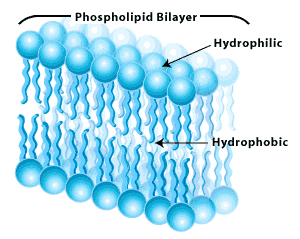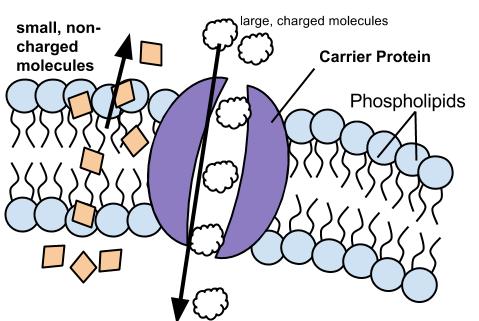Chapter 5 - Membrane Structure and Function
The Plasma Membrane
fluid mosaic model, semi-permeable (selectively permeable), double layer of phospholipids with embedded proteins
Jobs of the cell membrane
- Isolate the cytoplasm from the external environment
- Regulate the exchange of substances
- Communicate with other cells
- Identification
Phospholipids (fats) contain a hydrophilic head and a nonpolar hydrophobic tail, which creates a barrier.

Cholesterol - stiffens the membrane by connecting phospholipids
Glycolipids - signal molecules
Glycoproteins - have an attached chain of sugar (antibodies)
Proteins embedded in membrane serve different functions
1. Channel Proteins
- form small openings for molecules to difuse through
2. Carrier Proteins- binding site on protein surface "grabs"
certain molecules and pulls them into the cell, (gated channels)
3. Receptor Proteins - molecular triggers that set off cell responses
(such as release of hormones or opening of channel proteins)
4. Cell Recognition Proteins - ID tags, to idenitfy cells to the body's
immune system
5. Enzymatic Proteins - carry out metabolic reactions

Transport Across Membrane
-The membrane is selectively permeable (also called semipermeable )
-
Small particles, or particles with no charge can pass through the bilayer (carbon dioxide and oxygen)
-
Water has a charge, does not easily cross the membrane - a channel protein, Aquaporin helps water across
Passive Transport
Simple
Diffusion - water, oxygen and other molecules move from areas of high concentration
to areas of low concentration, down a concentration gradient
Facilitation
Diffusion - diffusion that is assisted by proteins (channel or carrier proteins)
Osmosis
- diffusion of water
Solutions: Hypertonic | Isotonic | Hypotonic

Contractile vacuoles can help pump out excess water in freshwater organisms
The central vacuole of plants can store excess water, creating a turgor pressure; plants are less likely to burst due to cell walls
Active Transport
- involves moving molecules "uphill" against the concentration gradient, which requires energy (ATP)
Endocytosis
- taking substances into the cell (pinocytosis for water, phagocytosis for solids)
Exocytosis - pushing substances out of the cell, such as the removal of waste
Sodium-Potassium Pump - pumps out 3 sodiums for ever 2 potassium's taken in against
gradient

